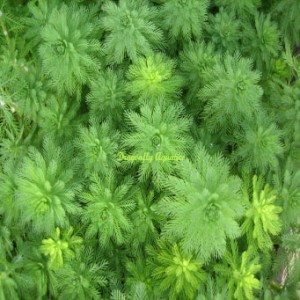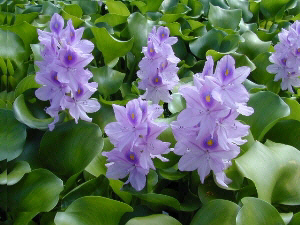 A favorite floating pond plant for all pond owners. Parrots Feather has feathery bright green foliage that floats out over the pond. The leaves may be 3 inches or more in diameter and grows on long trailing stems. It is hardy in Zones 6-11 and will grow in sun to part shade. Parrots Feather will root and form more full plants by snipping them if they get too tall. You can take the cuttings and pot them until they root, or stick the cuttings in between rocks at the waters edge, making sure the cut ends are submerged in water. The Parrots Feather will develop roots and anchor itself in the muck between the rocks. I have parrots feather in my bog that winters over year to year. And here in Ohio, we are known to have some pretty cold winters.
A favorite floating pond plant for all pond owners. Parrots Feather has feathery bright green foliage that floats out over the pond. The leaves may be 3 inches or more in diameter and grows on long trailing stems. It is hardy in Zones 6-11 and will grow in sun to part shade. Parrots Feather will root and form more full plants by snipping them if they get too tall. You can take the cuttings and pot them until they root, or stick the cuttings in between rocks at the waters edge, making sure the cut ends are submerged in water. The Parrots Feather will develop roots and anchor itself in the muck between the rocks. I have parrots feather in my bog that winters over year to year. And here in Ohio, we are known to have some pretty cold winters.
Sometimes you will see parrots feather listed as an oxygenating plant, but this variety is not commonly grown underwater.
Parrots feather grows in moist soil or up to 6 inches of water, but will float over any depth. They do great in the top of a waterfall, a bog area, stream bed or in a container water garden.
 Water gardening is easy with floating plants. Just place in the water and they drift effortlessly in your pond. The roots of floating plants dangle down into the water where they draw nutrients for the plant's growth. Floating plants provide shade for your pond while creating a place for fish to hide under to protect them from the hot summer sun. They also give them a place to hide from predators, such as herons or raccoons. The greatest benefit of floating plants is they help with your ponds filtration.
Water gardening is easy with floating plants. Just place in the water and they drift effortlessly in your pond. The roots of floating plants dangle down into the water where they draw nutrients for the plant's growth. Floating plants provide shade for your pond while creating a place for fish to hide under to protect them from the hot summer sun. They also give them a place to hide from predators, such as herons or raccoons. The greatest benefit of floating plants is they help with your ponds filtration.
Some of the floating plants, such as water lettuce, water hyacinth and parrots feather are good for filtrating. Their tiny hairy roots absorb nitrates and phosphates from the water and help in creating a good filtration. By taking these nutrients in it prohibits algae growth and green water. Azolla and duckweed are also filtration plants. Your other floating plants, such as sensitive plant and frogbit will only filter nutrients from the water and don't help combat green water.
Remember not to place floating water plants in your pond until the water temperature have reached 65 degrees. They will show signs of yellowing leaves and black spots on their leaves if left in water temps below that. We tend to get anxious in the spring and sometimes put floaters in before the water is warm enough.
If you want to try and keep them over the winter you may try floating them in a tray or aquarium. Its difficult and not always successful but worth a try if you so desire. You need to keep the water around 70 degrees and they need about 12-14 hours of sunlight. With it being hard to get that much sunlight during the months of January and February you would have to keep a growing light on them about 12 inches over the water. You may find that its cheaper just to replace them yearly due to the cost of energy and electricity required to keep them growing over the winter.
Caring for these plants is minimal and a great asset for your pond. Some states discouraged or even ban them from possession due to their growth rate and spreading rate. You should never add to a natural body of water. If you aren't sure about your area make sure you compost them into your vegetable bed. You can always check with your state regarding the laws that prohibit these plants.